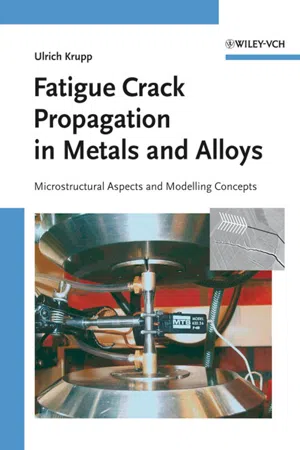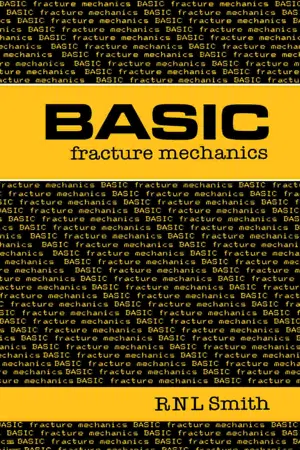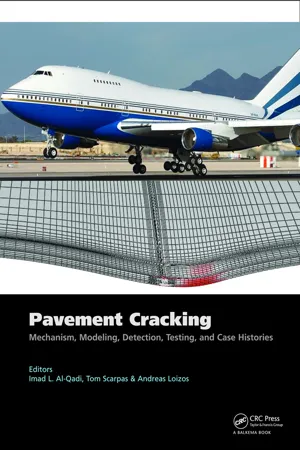Technology & Engineering
Paris' Law
Paris' Law is a mathematical model that predicts the growth of fatigue cracks in materials subjected to cyclic loading. It states that the rate of crack growth is proportional to the range of stress intensity factor raised to a power. This law is widely used in the design and analysis of structures and components subjected to cyclic loading.
Written by Perlego with AI-assistance
Related key terms
1 of 5
4 Key excerpts on "Paris' Law"
- eBook - PDF
Fatigue Crack Propagation in Metals and Alloys
Microstructural Aspects and Modelling Concepts
- Ulrich Krupp(Author)
- 2007(Publication Date)
- Wiley-VCH(Publisher)
More recent devel- opments based on the experimentally gained knowledge of the interactions men- tioned above (see also Chapters 5 and 6) are reviewed in Chapter 7. The following section is focused on the rather empirical Paris law of fatigue- crack propagation, which has been introduced by Eq. (2.5), and some of its modifi- cations. Even though, these approaches consider the microstructure only by mate- rial parameters they have become increasingly established in lightweight design in the aerospace and automotive industry. The damage-tolerant design approaches postulate that generally each compo- nent contains imperfections in the form of cracks. However, these cracks are able to propagate only when a certain critical length is exceeded. This behavior is repre- sented for most materials by the characteristic sigmoidal relationship between the logarithm of the crack-propagation rate da/dN and the range of the stress-intensity factor ΔK (see Fig. 2.12) where the linear part can be described by Paris’ law (Eq. 2.5). The latter includes the concept of transferability of LEFM; i.e., by combining the stress range Δσ, the crack length a and the geometry function Y for a crack in a component within the parameter ΔK, the individual dimensions of a component are eliminated. Hence, the linear part of the log(da/dN) vs. log(ΔK) curve is de- scribed by Paris’ law as follows: (2.14) da dN C K C aY n n = = ( ) Δ Δσ π 19 2.2 Metal Fatigue, Crack Propagation and Service-Life Prediction: A Brief Introduction Only when ΔK exceeds regime I in Fig. 2.12, i.e., the threshold value of the range of the stress-intensity factor ΔK th (corresponding to a critical combination between nominal stress range and crack length), is an existing crack considered as techni- cal crack that can propagate. It will be shown later that this assumption is not val- id for microstructurally short fatigue cracks. - eBook - PDF
Basic Fracture Mechanics
Including an Introduction to Fatigue
- R N L Smith(Author)
- 2013(Publication Date)
- Butterworth-Heinemann(Publisher)
The determination of a Paris-type law is considered as an example in chapter 6, section 6. We can now use the Paris law to predict the number of cycles re-quired for a crack to grow from length a/ to ap. Rearranging equa-tion (5.4) and integrating: N = / „ . . ^. da (5.5) Using the definition of and taking constants outside the integral, the above equation becomes: N= C(Aa^)Co^ da (56) Now if we assume that Q does not vary with a, Q can be taken outside the integral which may then be performed exactly (for τηφ'ϊ) giving iv= x CiQAayft)™ l -m / 2 l -m / 2 j — a F m / 2 -1 (5.7) If Q is a known function of a (fitting a polynomial to data if neces-sary) then it may be possible to integrate exactly. It is generally more convenient to integrate numerically. Program 5.2 below uses Simp-son's rule (section 3.3) to integrate equation (5.6) and hence obtain the required number of cycles for a given increase in crack length. As an example we first take a central crack in a large sheet so that Q = 1. P r o g r a m 5.2 PCG: Crack growth using the Paris law. 100 PRINT FATIGUE CRACK GROWTH USING THE PARIS LAW 110 INPUT STRESS RANGE (MPA);R 120 INPUT INITIAL CRACK LENGTH AI (M) M ;A0 - eBook - ePub
Reliability and Risk Models
Setting Reliability Requirements
- Michael Todinov(Author)
- 2015(Publication Date)
- Wiley(Publisher)
et al., 1961):(12.11)where a is the crack length; N is the number of load cycles and is the range of the stress intensity factor. and are the stress intensity factors which correspond to the maximum (σmax ) and minimum (σmin ) value of the uniform tensile stress perpendicular to the crack plane. Consequently, , where is the stress range. In some cases, and . Because fatigue cracks do not propagate if the loading stress is compressive, in this case, in calculating the stress range, the minimum stress should be set to zero ( ) and the stress range becomes . Y is a dimensionless factor that depends on the geometry of the loaded crack.Although the Paris law is empirical, it remains one of the most useful expressions for making conservative estimates of the life of components and structures. This equation is valid beyond a specific threshold value ΔKth of the stress intensity factor which defines a fatigue crack which is capable of propagating in the material. For relatively short propagating cracks, it can be assumed that the geometry factor Y is independent of the crack length a - eBook - PDF
Pavement Cracking
Mechanisms, Modeling, Detection, Testing and Case Histories
- Imad L. Al-Qadi, Tom Scarpas, Andreas Loizos, Imad L. Al-Qadi, Tom Scarpas, Andreas Loizos(Authors)
- 2008(Publication Date)
- CRC Press(Publisher)
Pavement Cracking – Al-Qadi, Scarpas & Loizos (eds) © 2008 Taylor & Francis Group, London, ISBN 978-0-415-47575-4 Measurement and effective evaluation of crack growth in asphalt mixtures H.A. Khalid & I. Artamendi University of Liverpool, UK ABSTRACT: A cyclic semi-circular bending beam test was used to study the crack propagation characteristics of two materials: a cold emulsion asphalt and its hot mix equivalent. Linear elastic fracture mechanics principles were used in the analysis which evaluated the materials’ stress inten-sity factor and the Paris Law constants. Two approaches were adopted in interpreting crack growth: a simple straight line method and an effective, more accurate crack path depiction. Results showed that the cold mixture crack growth rate is less sensitive to applied stress than that of the hot asphalt. Although crack growth rate was found higher with the effective interpretation method, the influence of the two methods on the Paris Law parameters for both materials was found insignificant, given the observed data scatter. 1 INTRODUCTION Fatigue cracking of asphaltic materials is a predominant distress mode that is assessed in the laboratory in a variety of ways. Fracture mechanics tests have been increasingly used to depict crack propagation in asphalt based on linear elastic analysis. Irwin (1957) introduced the stress intensity factor, K, to uniquely define the stress field at the crack tip. In pure tension loading referred to as mode I, Paris & Erdogan (1963) found that the crack growth rate is a function of the stress intensity factor, K I , of that loading mode. The relationship between K I and crack growth rate is commonly known as the Paris Law. Much interest has recently been witnessed in the semi-circular bending (SCB) test as a laboratory tool to study the resistance to crack propagation of asphalt mixtures.
Index pages curate the most relevant extracts from our library of academic textbooks. They’ve been created using an in-house natural language model (NLM), each adding context and meaning to key research topics.



